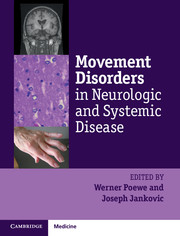Book contents
- Frontmatter
- Contents
- List of contributors
- List of videos
- List of abbreviations
- Preface
- Section I General principles
- Section II Movement disorders in systemic disease
- Section III Iatrogenic and toxic movement disorders
- Chapter 14 Drug-induced movement disorders
- Chapter 15 Movement disorders associated with chronic metal poisoning
- Chapter 16 Movement disorders following non-metal intoxications
- Section IV Movement disorders in general neurology
- Section V Systemic complications of movement disorders
- Index
- Plate Section
- References
Chapter 15 - Movement disorders associated with chronic metal poisoning
from Section III - Iatrogenic and toxic movement disorders
Published online by Cambridge University Press: 05 April 2014
- Frontmatter
- Contents
- List of contributors
- List of videos
- List of abbreviations
- Preface
- Section I General principles
- Section II Movement disorders in systemic disease
- Section III Iatrogenic and toxic movement disorders
- Chapter 14 Drug-induced movement disorders
- Chapter 15 Movement disorders associated with chronic metal poisoning
- Chapter 16 Movement disorders following non-metal intoxications
- Section IV Movement disorders in general neurology
- Section V Systemic complications of movement disorders
- Index
- Plate Section
- References
Summary
Introduction
In the periodic table of elements, there are sixty-seven metals, characterized by metallic luster, high thermal and electrical conductivity, strength, and ductility. Metals are often extracted as ores from the Earth’s core by mining and some are useful for carrying large loads or resisting impact damage. Some metals are required for enzymatic processes and their intake is regulated by homeostatic mechanisms, while others interfere with intracellular functions of essential metals, but also excess of essential metals may cause toxicity by free radical mediated oxidative stress, impairment of mitochondrial function and disturbed energy metabolism, and alteration of protein structure. Metal toxicity may occur from overload as a consequence of external exposure – industrial, accidental, or from drugs – and may affect the function of many organs as well as the central and peripheral nervous system. Clinical manifestations caused by metal toxicity vary greatly, and include movement disorders such as secondary parkinsonism and a wide range of hyperkinetic disorders (see Table 15.1).
- Type
- Chapter
- Information
- Movement Disorders in Neurologic and Systemic Disease , pp. 220 - 233Publisher: Cambridge University PressPrint publication year: 2014

